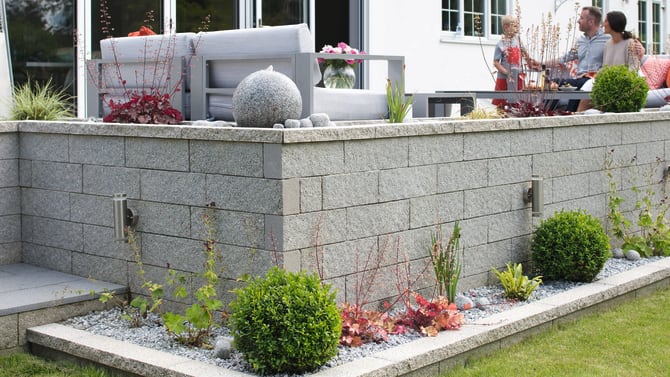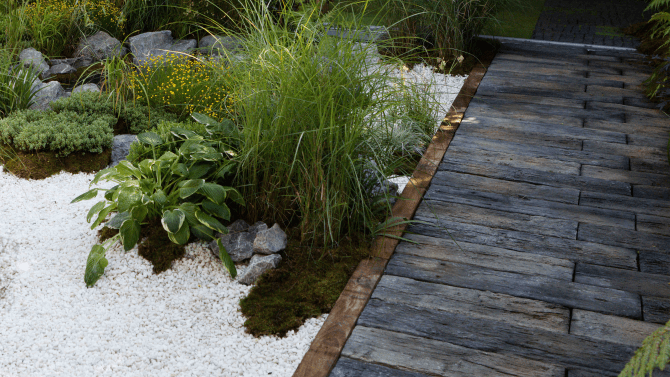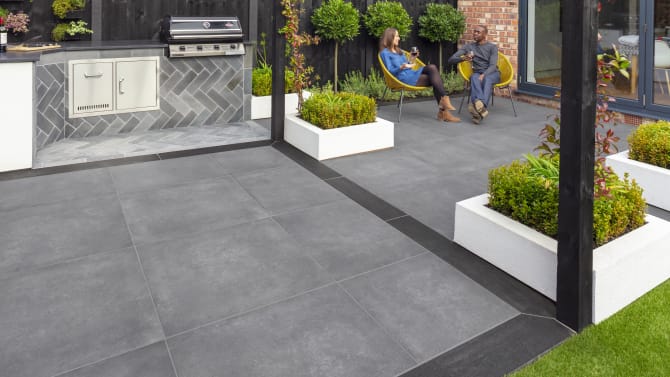Blog
If you're struggling to figure out how to turn your sloping or stepped garden into an attractive and functional outdoor space, you're not alone, as landscaping a hilly garden can be quite a daunting project to undertake.
Don’t worry, though, our garden design experts have scouted high and low to find you the best of the best when it comes to stepped garden design ideas.
So, whether you’re after a multi-level wilderness or chic manicured terraces, we've got all the inspiration you need.
Carry on reading to learn 16 of the best stepped garden ideas.
1. Incorporate curves

Marshalls Sawn Versuro Borders
Disguise the steepness of your garden by creating winding pathways bordered by curving garden walls. By creating a zig-zagging path across your garden, you’ll be able to achieve a gradual slope that is easier to traverse in all weather. This will also allow you to build several different terrace areas that can be filled with plants or even turned into separate zones for entertainment.
Embracing the slope by installing tiered sections rather than flattening them gives you more variety and will also result in greater visual interest.
2. Combine sloping beds with sleek steps

Marshalls Granite Eclipse® Steps
Sleek natural stone steps are an excellent way to add flair to your sloping garden. You can add lush and colourful garden beds on either side of the steps to contrast the sharp edges or landscape with crisp edges to create a bold stairway down the garden slope.
Planting the sloped areas on the side of the stairs with grasses, shrubs, flowers, and small trees adds visual drama to your garden design and creates an inviting habitat for different wildlife.
3. Build a unique gabion retaining wall

Marshalls Croft Stone® Walling
If you’re looking to introduce terraces to your stepped garden, you'll need to add a retaining wall at each level. This helps to add structure to your design and prevent landslides from happening. Most stepped garden ideas require at least one retaining wall, so looking at the available options before starting your design is a good idea.
These walls are a crucial part of a stepped garden design and an easy, practical way to add interest to your space. In particular, stone-filled gabions work great for gardens with stepper slopes or inclines, as they are strong, attractive, and don't impede drainage meaning any plants can thrive without becoming waterlogged.
4. Opt for tiered planters

For those working with a small garden and a steep slope, utilising tiered planters is a great way to avoid creating too many hard lines and sharp divisions. Alternatively, using curved edges can create dispersed, tiered beds and keep the overall look delightfully soft on the eyes.
Fill the planters or beds with varying sizes and include some lightweight foliage that will sway in a breeze. While you’re at it, why not add a few rounded stone steps to create a pathway along the stepped garden to complete the look?
5. Use the steps to showcase your stunning garden design

Marshalls Casarta® Slate Steps
One of the best aspects of a steps garden is that it is a wonderful way to show off your fantastic landscaping concept. When viewing a stepped garden from your home or patio, you'll experience the full vista of your perfect oasis without any elements being obscured from view.
Be careful not to detract from the beauty of the planting schemes by using too much hard landscaping. Rather, keep your steps and pathways to a practical minimum and choose natural, inconspicuous garden edging and paving.
Create structure by planting trees at various points on the steps and sloped areas and using layers of shrubs in your beds and as borders. In the gaps, plant colourful perennials and ornamental grasses. To maintain a lush and abundant aesthetic, you could also have trailing plants along the retaining walls and cover fences with creepers or trellises.
You can find out more about small patio ideas on our blog.
6. Add a sunken seating area or patio

Created by Westend Landscapes, Clevedon, using Marshalls Arrento® Porcelain Paving
Terraces allow you to design various useful spaces, like an outdoor dining or kitchen area with sunken seating. This type of built-in seating is also a great way to maximise the potential of the available space by sitting discreetly amongst the other features in your garden.
Consult a landscape designer to ensure your retaining walls are strong enough to hold the structure you want to build. They'll also be able to advise on the best materials to use, including garden walling and paving, and they can help you to create a lighting scheme for the space.
Keep the design chic and simple to maximise the impact and allow it to sit in perfect harmony with any foliage planted in the surrounding areas.
7. Create a rockery

There are several ways to add rockery to your stepped garden. From a cottage garden aesthetic, with a rustic feel and quirky steps, to a Japanese-inspired zen retreat, a rockery area is a great way of transforming your stepped outdoor space.
To achieve the cosy look and feel of a cottage garden, be sure to use reclaimed stone for your pathways, steps, and retaining walls. Add round top edging where needed, and don't be afraid of having uneven levels and different heights - this will just add to the charm. Use plants typically associated with cottage gardens to finish off the look.
For those opting for something more oriental, a great way to incorporate natural stone paving into your stepped garden is to follow Japanese garden design ideas. If you have a rocky section in your garden, choose to make it the main feature rather than remove it. Surround rocky outcrops with low-growing sedums, and add small plants into nooks and crevices.
8. Fill the gaps with flower beds
When you have a garden that slopes downwards away from your home or patio, you may find an empty space of bland wall that needs to be covered. This can easily be fixed with the addition of a flower bed.
To keep your garden looking fresh, intersperse perennial flowering plants with evergreen shrubs to ensure year-round greenery and keep different species of animals coming into your garden.
If you'd like to make it seem like the two terraces being level, you can plant taller vegetation in the bed so that it grows past the floor of the patio. This is a great way of maintaining the illusion of there being a smooth slope from your house all the way down to the bottom of your garden.
9. Build a raised pathway
Although terracing adds so much to your garden, it can also be quite expensive and time-consuming. But, for anyone on a tighter budget or with less time on their hands, there are a few DIY alternatives you can try.
One of these options is a raised pathway. Using timber, you can create a terraced look with a fraction of the effort. By running a pathway horizontally across one of the tiered sections in your sloped garden, you can connect steps to the lower levels depending on their height. Adding railings is also a good idea if you are worried about falling, especially for anyone who is less steady on their feet.
To add some visual interest between pathways, make sure to plant a hillside flower bed in-between each section that is brimming with colourful buds and blossoms.
10. Incorporate grass steps into your garden design
Not a fan of hard landscaping but need to add steps to your stepped garden? Grass treads are the way to go! Soft under feet, gentle on the eyes, and fitting seamlessly into the rest of the garden’s design scheme, these steps are the perfect solution for those wanting a more natural feel.
Grass steps help make a terraced or stepped garden feel less structured, but they also make the design flow better and allow for smooth transitions between each level. If you're keen on rolling green lawns, this will help you maximise the coverage of your lawn.
11. Make it fun by adding a slide!
One of the most fun sloping garden ideas is the addition of a slide! Whether you have kids or not, this is a unique and exciting way to add a transition between levels. You can choose a standard plastic or aluminium children's slide, or you can opt for a custom-made design that is accessible for everyone.
Place it alongside a flowing water feature or between flower beds to add further appeal to your garden.
12. Use the levels to demarcate zones
To fully maximise the potential of your space, think about separating areas of your stepped terrace garden into distinct zones. While having an extensive garden filled with foliage and flowers is lovely, having ample space for entertaining guests and relaxing is also important.
Consider adding an outdoor seating area with a great view for enjoying sunny evenings with friends and family. An alfresco dining area is another great addition and should be placed fairly close to the kitchen for easy access. You could even add a hot tub to the corner of your garden, but think about keeping it further away from your home to make it a more intimate area that’s sheltered from the elements.
You may even wish to keep a sunny section aside for a kitchen garden, which can be built using raised beds. Perhaps locate this close to your grill or outdoor kitchen.
Learn more about how to create zones in your garden.
13. Add movement with water features

Marshalls Fairstone Sawn Versuro® Jumbo
There are so many great ideas for adding water features to a stepped garden. You could incorporate a trickling waterfall over a retaining wall or run a stream over a rustic stone garden path. The calming sound of water features is a great way of creating a peaceful atmosphere in your outdoor living space.
Why not replicate a natural stream by guiding it through your flower beds and over the stone walls into a lush pond? Alternatively, you can add a water feature, such as a fountain, as a focal point in the middle of your stepped garden.
Create a tranquil retreat by adding comfortable garden furniture to a secluded spot near the water feature. If you're on a budget, creating a simple bench using railway sleepers will work wonders to create the most calming space.
If your property has unwanted noise from a nearby road or industrial area, a water feature can create natural white noise that will help to drown out any irritating sounds.
14. Create a terraced kitchen garden

The wonderful thing about terraces is that they enable you to maximise the potential of your available space and make it easier to create different zones in your garden. Terraces can be used for a kitchen garden with an outdoor cooking or dining area.
By placing a vegetable garden on one of the lower levels, you'll not only have easy access to veggies for dinner, but you'll also improve drainage. The veggies will soak up a lot of the runoff water, reducing the chance of flooding.
15. Create consistency with kerbs and edging

When designing a multi-level garden, you'll need to balance the separation of zones with good flow and design consistency. A very simple way to do this is to line your paths with the same type of edging throughout the garden. Rounded kerbs and edging help soften the garden's overall look while maintaining a consistent style through all zones.
Choose a style that works best with the garden's aesthetic and your home's exterior design to make the spaces feel visually coherent. If you opt for something contrasting, be sure that it doesn't clash with any established design choices.
16. Go luxury with a hot tub
If you want to feel like you're in the lap of luxury, install a hot tub at the top of your stepped garden. You'll be able to spend afternoons and evenings relaxing while enjoying the beautiful vista you've created. You could even add a small outdoor bar alongside it!
Lead the way to the hot tub with some sleek stone steps, ensuring they have a non-slip surface. Adding a patio or terrace next to the pool is a great place for a seating area, and you can also add loungers and outdoor fairy lights to build more ambience.
For more information, check out our other guide on sloped garden and driveway design ideas.
Design your perfect stepped garden with Marshalls
Here at Marshalls, our teams have over 120 years of experience in helping you create the garden of your dreams. Your project is our passion, and we give care and attention to every element of the products we supply and to the services we provide.
Whether you want to create an urban oasis filled with contemporary features or a countryside haven brimming with rustic charm and character, our experts are on hand to give you the best advice on how to create your perfect garden one stone at a time.
If you’d like more information on other aspects of your garden such as driveways or garden paving,, have a read of the other articles over on our blog and make use of our interactive design tools get your next landscaping project off to a flying start.
FAQs
What is a stepped garden?
Also referred to as a terraced garden, a stepped garden is built on a sloping site and uses retaining walls to keep the soil sturdy.
Depending on the garden designer, the whole garden may be transformed into different levels, or there may be a combination of steps and sloping areas. Some stepped gardens are turned into multi-use spaces with a different design scheme at each level whilst others follow the same theme throughout.
How do you terrace a sloping garden?
To terrace a sloping garden, you'll need to build a retaining wall at each level to ensure that soil remains sturdy and that your tiered design remains strong. However, some terraced garden ideas will need planning permission.
If you want to terrace a garden with a steep slope, it is recommended that you get professional advice from a garden designer before starting the project. They will be able to advise which sloping garden ideas are best suited to your space.










